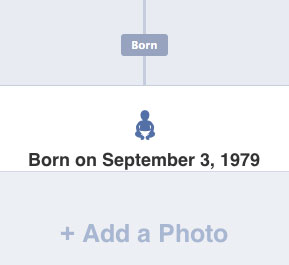The Ever-Changing Face of Facebook
October 2011
By Jeremy Hunt
With the advent of another quarter comes another sweeping round of changes from our good friends at Facebook. In what is becoming a weird mix of techie tradition and rage-inducing behavior for the average Joe, Facebook will be rolling out a barrage of new updates over the upcoming weeks.
Now that the inevitable initial backlash has subsided (You changed ma Facebooks!1! Facebook is going to start charging for their services!!), let’s dive in and look at what’s ahead.
Timeline

The most significant update is the introduction of the Timeline – Facebook’s version of an online scrapbook. Once it’s been fully rolled out, the Timeline will replace the user’s profile page and will more closely resemble a blog, complete with a header image, summary bio information and a quick overview of friends, photos, likes and notes.

Scrolling further down the Timeline, you’ll see highlights from the user’s Facebook footprint over the years, laid out in reverse chronological order. Scroll down far enough, and you’ll see a hilarious new section for the user’s birth.
Yes, Facebook is no longer content with shaping our present and future. Zuckerberg & Co. have now devised a way to retroactively insert themselves into our past, too.
All joking aside, the interface is fairly intuitive and fun. While some have raised privacy concerns, as with every other service that Facebook offers, Timeline only works with the information that its users provide. Preventing photos or life events from being made public is as simple as not posting them.
News Ticker

If the Timeline is the most visually appealing new update, the News Ticker is probably the least (and possibly most annoying).
The Ticker is like status updates on steroids, providing running commentary – er, updates – whenever one friend comments on another friend’s photo, comment, etc.
Whereas previously a user’s interaction with their friends’ updates was mostly limited to the ones they commented on or liked (triggering notifications whenever someone else subsequently commented on the same item), Ticker operates from the assumption that users don’t want to miss a single instance of activity between any of their friends.
While I’m not necessarily opposed to the concept of the Ticker, in its current iteration, it definitely feels like information overload. It would be preferable if this feature could simply be hidden or deactivated.
Subscribe
Taking a page from Twitter, Facebook now makes it possible to subscribe to a user’s profile, rather than adding them as a friend. So in case you want to follow (a la Twitter) someone you don’t know on Facebook without the creep factor of adding them as a friend, now you can just subscribe to their updates. Then again, maybe that is the creepier of the two options…
Smart Friends lists
Oh, Facebook, again with the blatant Twitter homages. Their new “smart” Friends lists are exactly what they sound like: Facebook creates and auto-populates certain default categories (work, school, family, city) of Friends to allow users to easily view updates only from contacts in that particular group.
This isn’t necessarily a bad update, but it’s probably only truly useful for those who are approaching their 5,000 friend limit and need an easy way to slice and dice their friend-base.
Recent Stories vs. Top Stories
Finally, Facebook has revamped the way updates are displayed in the home news feed. In the past, users had the option to choose between “All Updates” – activity from all friends displayed in reverse chronological order – or “Top News,” which was aggregated and ordered based on Facebook’s EdgeRank algorithm.
Facebook has now eliminated these options by creating a hybrid of the two. The jury is still out on this new beast, but it appears that it might not be a bad compromise.
On login, Facebook displays a selection of “Top Stories” mixed with “Recent Stories.” As a user spends more time on their home news feed, Top Stories are filtered out and the feed returns to a straightforward view of Recent Stories (i.e., updates from friends/pages as they happen in real time).
Users also now have the power to select certain updates as Top Stories to further customize their news feed in the future. Conversely, they can deselect those updates that don’t make the cut for relevance and interest.
What do these changes mean for you?
While none of the most recently announced changes directly affect Pages, they are not without implications for those who use the platform to engage with customers and clients.
First, the evolution of the news feed and the introduction of the Ticker mean that it’s more important than ever for brands to publish exceptionally valuable, relevant content that encourages interaction from fans in order to ensure visibility in their feeds.
Secondly – and perhaps most importantly – despite the latest round of loud complaints from its most vocal users, Facebook’s growth shows no signs of slowing. Recent data from Nielsen indicates that users are spending an ever-increasing amount of time on Facebook – more time even than on Google, Yahoo, AOL and Microsoft sites combined. And Facebook remains dedicated to driving innovation in their interface and the ways that users can engage with the platform. As new options and features continue to emerge, Facebook will become the default online home base of more and more users, making it an invaluable vehicle of communication between companies and their customers.
Jeremy Hunt is a writer, communicator and social media grunt who lives in Charlotte, North Carolina. He currently serves as the manager of corporate social media for Novant Health. Keep up with all that he finds cool in the world at jeremyhunt.tumblr.com or follow him on Twitter: @jehuthehunt.